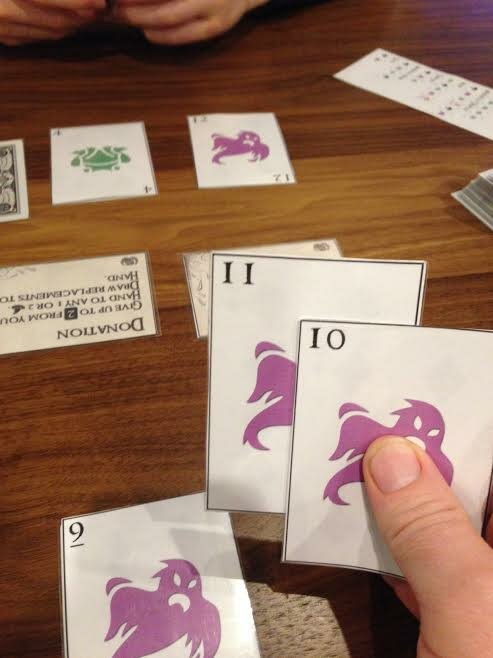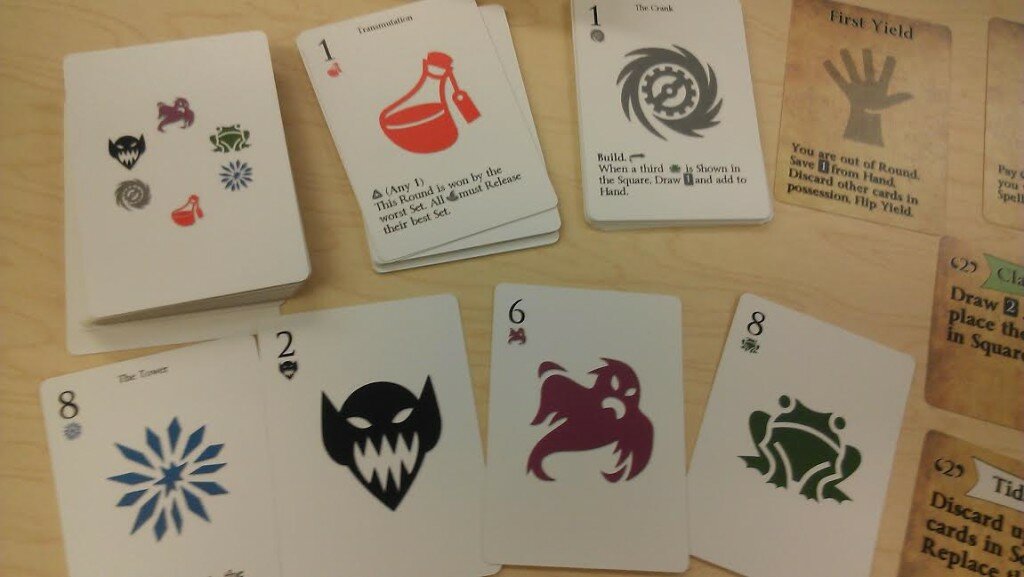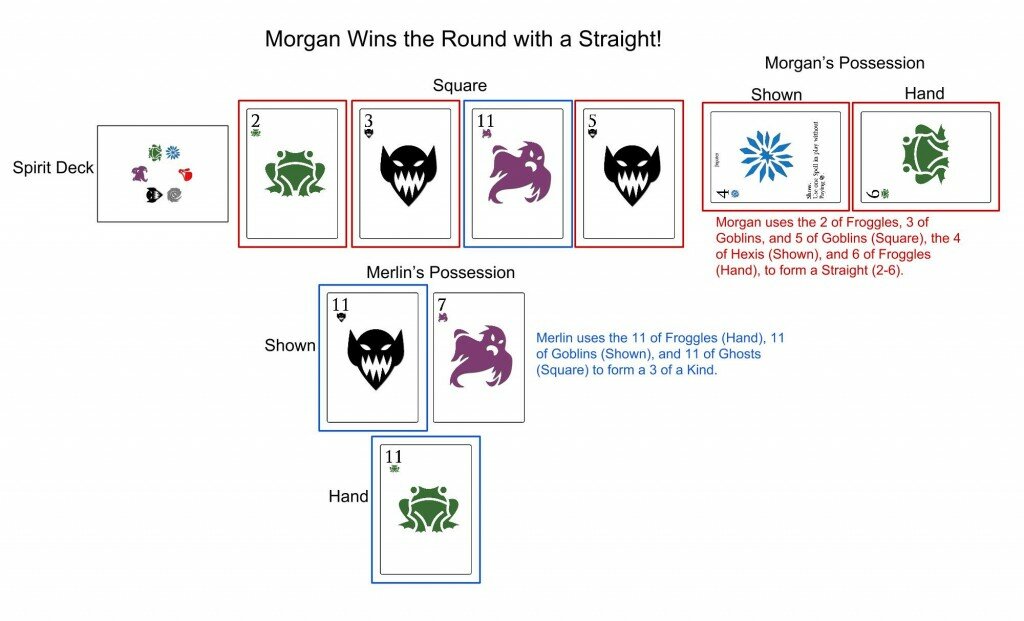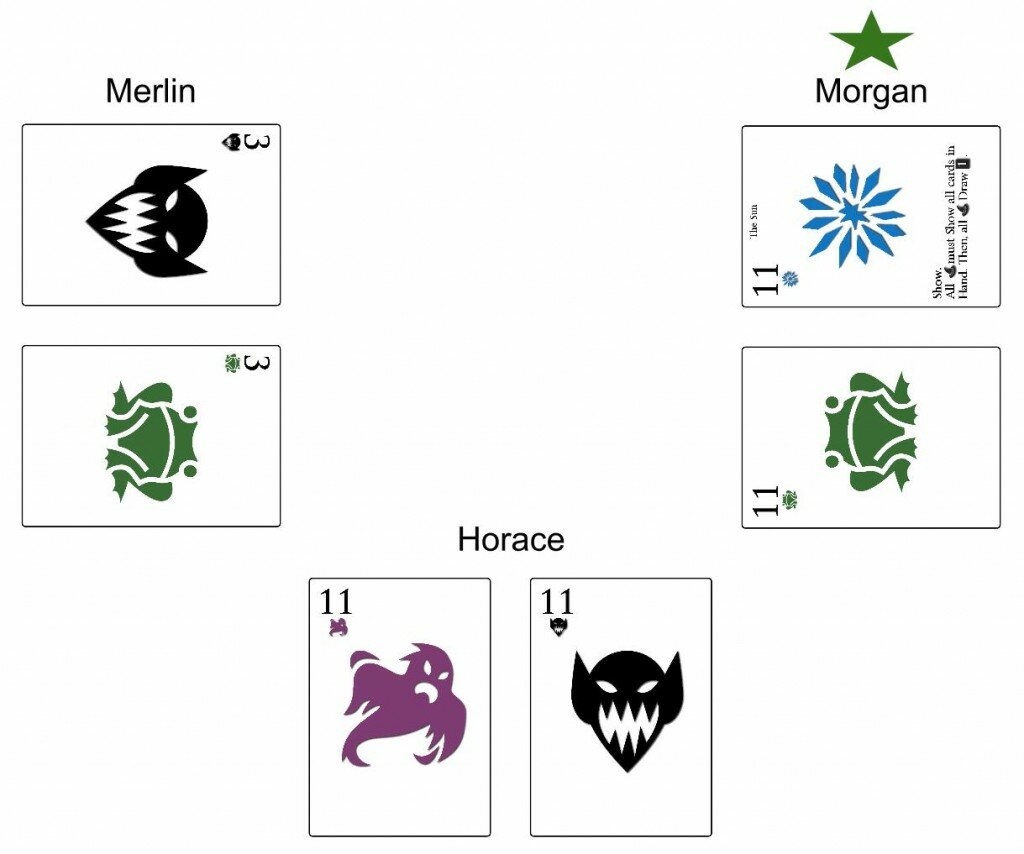Post by: Joshua Buergel and Grant Rodiek
This post is a part of our weekly series discussing Hocus Poker.
Grant: Game development is always about choices, opportunity costs, and making the best feature set. One of our goals for Hocus Poker has always been to create an expandable, highly replayable game with a ton of variety. You can see it throughout our mechanics.
- 26 Spells that are randomly drawn to create a new pairing every round.
- Spells are chopped up into 3 tiers so new players can ramp up simply without being overwhelmed or confused.
- Hexis cards and other Arcana, which introduce yet another layer of hidden information as you build your hand.
- Variants to support 5 and 6 players.
Sometimes a feature doesn’t work out, and then you have to ask yourself: Is this worth developing? Or, should we set it aside and move on?
Choosing the latter is you admitting to failure and you may not have a replacement.
Josh: At various times in this project, I thought that we had hit the bottom of our creativity in developing spells. We were still finding bad ones, and I was really skeptical of the idea that we’d be able to cook up better replacements. That fear turned out to be unfounded, as we did manage to basically land that ship, but the thought was in the back of my mind: had we done all we can?
Recognizing that you cannot go further, that’s a tough thing to think about. It feels like admitting defeat because, in a lot of ways, it is. It’s also hard to look at a thing you created and proclaim that it’s not good enough. If it’s just a single card, component, or other piece of content, well, that’s not so bad. But what if it’s an entire thing?
Grant: We should stop beating around the bush. While Hexis, as an Arcana Suit, works really well and has tested well many times, Mechana and Alchemis just don’t work. The reasons they don’t work are pretty clear, too.
Briefly, let’s talk about why Hexis works. For one, you can always activate them. The only requirement is that you Show the card by placing it in front of you. Hexis card isn’t always useful to play, but that is fine and intended.
Josh: It fits seamlessly into the flow of the game, providing more options and more color without gumming up the works.
Grant: Therefore, we went and violated that for both Alchemis and Mechana. Both of these have very specific requirements to play, which means they rarely actually happen. And when they do, they have questionable value.
Josh: That, incidentally, was a conscious choice at the beginning. We both thought that it would be an interesting thing to have additional suits that provided a qualitatively different way of approaching the game. It would allow players to have options in what sort of game they were playing. At least, that was the idea.
Grant: Alchemis, for example, requires you have a very specific set of cards and that you discard them. Not only do you need to get incredibly lucky, but then you have to toss them in the hopes you get something better! Sadly, this is the second time we’ve tried it. It was my first idea actually for how to activate spells – discard things to use the spells. Josh, not knowing this, independently came up with a similar idea. It seemed better. Sadly, it works about as well.
Josh: Sometimes parallel evolution leads you down the same blind alley. Here’s the thing: discarding cards in most card games is fine. It’s a cost, sure, but it’s a straightforward cost for players to evaluate, and it can be a simple way of balancing strong abilities. That logic just doesn’t really work for poker, apparently. Players have to constantly re-evaluate what the hand they’re holding is worth, and that dynamic is apparently toxic when combined with having to discard as a cost.
Grant: But, let’s say there’s value in making the trade-off. Getting it alone is nearly impossible. You’d have to chase the entire round hoping you get the cards. It became another game all by itself, but it just didn’t really work. We evolved the mechanic so that instead of discarding all the cards, you’d just discard the Alchemis card. And instead of having to have them all in your hand, you just needed them in your possession.
Aside from the fact the balance of the abilities was bonkers, it still wasn’t really something you could count on. At most, it’d be like “oh! Hey! I can do a thing.” Which isn’t really what we were going for.
Josh: Well, in my head, I had pictured the this suit being high-value and rare, but that dynamic is really only appropriate for a game with longer hands, I think. Here, there are only three action rounds you have in which to make it happen, and you can’t even count on saving to help you out, because the rest of your hand gets cycled. It’s not a game where you can simultaneously build a winning hand and put together a tricky formula.
Grant: Players just have to juggle too many things. It’s impossible to properly gauge the value of choices.
Josh: I do think that maybe the concept could be rescued down the road. But it would be a more radical change to the game’s structure: playing with hand limits, number of action rounds, the activation mechanism. Stuff like that. But that’s a tough road, and not really appropriate for an in-the-box thing.
Grant: I agree. I think the 3 Action Phase structure right now is too short and limiting. It needs to be paired with a longer game. Perhaps something a bit more meta than Hocus Poker.
Let’s discuss Mechana a little. The idea here was inspired by another original mechanic in the game — building a tableau of abilities. Which we tried in a variety of ways, including owning spells after a round if you lost. They were also inspired by Constructs in Ascension, or Star Bases in Star Realms.
The idea was that if you lost the hand, you could “build” a Mechana card in your possession. You would then gain its passive bonus if it was triggered. You could also use them in a hand, but then you’d lose their bonus. Clean trade off, right?
Josh: Sure sounded that way! I really liked the concept, anyway. There wasn’t anything else persistent in the game, with the exception of Runes/Charged status, so this seemed like a great way to fill that gap. But, the first problem with this suit can be summed up in one word: flush.
Grant: Yep. If every player has a Mechana suit in front of them, well, they are 20% on their way to a Flush. Guess what? In many tests, the two people with Mechana suits would tie out with a Flush in the same Hand.
Josh: It seems obvious now, in the cold light of day. I’m not sure why we didn’t spot that right away in the design phase.
Grant: Especially after we spent SO MUCH TIME balancing hands. Did we learn nothing? Answer: No.
Josh: Sometimes, it’s nice to be reminded that we aren’t so smart.
Grant: The other problem is that Mechana added yet another thing to track. So, players would need to worry about the cards in the Square, the cards in their Hand, the 4 spells (2 of which change every round), and the status of the Actions. Our players’ cups had runneth over. I’ve maybe played more Hocus Poker than anyone else and I constantly forgot to even use the ability.
Josh: This is a reprise of the problem we used to have with giving Spells as rewards. People would just forget about them. In some ways, this objection is not as bad as any of the other problems we’ve discussed, as people can train into being able to pay attention to this. But it’s a bad first impression, and having it in the box of the basic set gives people the idea it’s going to work.
Grant: The other issue is that in shorter games (2-3 players), they rarely mattered. You MIGHT see the trigger occur…but you probably won’t. So, now they were only really good with 4-5 players and even then, if it’s not interesting most turns, why add the complexity of the feature?
Oh, and it was super easy to forget which card in front of you was your Built Mechana, and which one might just be Shown.
Josh: Here’s the thing: we already have a way to play the game where you’re not getting cool abilities from the cards. You can ignore the Hexis abilities. And it works fine! We don’t need two other, fancier ways of not having cool stuff to do with your cards. It sounds cool to have these powerful, rarely activated things, but it just doesn’t fit with the snappy, rapid nature of Hocus.
Grant: On a slight tangent, we both clearly want a proper meta for Hocus Poker and really, if this thing funds and is successful, that’s what we should pursue. We’ll make a Trajan styled Euro where Hocus Poker is our Mancala Bowl.
I can begin speaking German, if it expedites ze process.
Josh: You people don’t even know. I have this idea of using Hocus Poker as the resolution mechanism in an adventure game, sort of like the way that you pull poker hands in Doomtown, but so much heavier.
At any rate, we have a problem. One of our cool ideas, of swapping out Hexis for entirely new suits, isn’t working. What now?
Grant: The idea was super good as a really clean expansion. In the same way that in Dominion you set up 10 different Kingdom cards, our thought was that you’d swap out your Arcana for an entirely new mechanic and experience.
Josh: It’s a great idea, I’m still convinced. But, this experience has taught me that maybe, what we should have is alternate Hexis suits. But that’s down the road, I think.
Grant: I am too. I just think, like the Hapsburgs, our pool has run a bit dry. That’s a genetic joke, so we’re clear.
Josh: A HISTORICAL genetics joke.
Grant: I might tap myself while laughing so hard, which will cause me to bleed unceasingly due to my hemophilia.
Here’s the other rub; it’s approximately the same cost, manufacturing wise, to print 80 cards as it is 104 cards. Cards are, typically, printed on sheets of 54 cards. If we print 55, we’re paying for 104.
Josh: The full press sheets are 108, but printers all can do half-sheets. It’s why you see those magic numbers come up in so many designs. You also have to worry about the size of your punch boards and whatnot, but the cards are a killer for printing costs.
Grant: We’re basically throwing away 24 cards now that we don’t have Alchemis and Mechana. Now, it isn’t a black and white issue. The art for these 24 cards would/will cost money and these cards also increase the weight, which could affect shipping and so forth.
The other cost, though, is quality. If we have a really good game with 80 cards, but 24 cards that are only so-so, that’ll bring down the overall rating. People won’t give us an 8+ because they like most of the game. They’ll give us a 5 because it all isn’t good.
You see this on Yelp reviews. I always laugh when someone raves about the food and the service, but gives a restaurant 2 stars because the music in the bathroom was weird.
Josh: I imagine someone playing a first game, then deciding to play a second with an Arcana suit. They pick one of the ones we’re discussing here because they like the theme, and it just does nothing. Nobody hits a formula. One play number two, they tried to use an advanced rule and it didn’t change the game at all except make it play slower. That’s a terrible, terrible experience, and even if we tell them that those suits should only be used after 20 games, or whatever, some people are still going to ignore that advice and jump right in.
Grant: The first few times I played the Power Up expansion for King of Tokyo, none of us evolved anything. We kept thinking “what’s the point?” Now, I’ve played it many times since and that opinion has changed, but initial impressions can be damming.
Josh: The standard has to be different for stuff in the basic box. Everything in there has to work great, essentially from the word go. Unless you seal it up in a separate envelope, Legacy-style, some subset of your audience is going to jump in head-first. And that’s great, the game should accommodate those people. It’s not for us to tell them how to play their game. It’s theirs! It’s presumptuous and strange for us to think we get to control their experience that way.
Grant: Both of us, potentially because of our background in software and design, are really into the idea of people creating variants and “modding” Hocus Poker. We’ve have testers sometimes say “well can I play this way?” And we always wink and say “we’re not in your living room. Go for it!”
So, let’s say we want to take advantage of those 24 cards. Technically, 28. What do we do with them. There are some easy ideas, including:
- Adding 2 Joker cards. Shuffle them in. If you draw one in your hand, it’s a wild-card.
- Adding 4 more Reference cards so that every player has one. I don’t think this is necessary, but we might as well.
Is there something cooler we could do?
Josh: Those are very prosaic and utilitarian. Nobody would object to that stuff, but nobody is going to get excited about them either.
Grant: Now now, Josh. There are some very weird people who will.
Josh: No dividers either!
More ideas that we’ve pitched back and forth, plus some new ones. Live brainstorming, people! Some of these ideas will suck out loud:
Grant: “Suck out loud” is one of my favorite phrases. It cracks me up every time.
The Brainstorm
Josh: Events in the main deck. This was Grant’s idea. This is a grand tradition in card games: you turn over a card to add it to the community, whatever, and Something Happens. I like this idea, with one of my favorite games that does this being the aforementioned Doomtown. You don’t want too many of these, though, or the impact is dulled. It seems like maybe you have a set of them, choose four, and randomly shuffle them into the deck. The advantage is that it’s low overhead in terms of people’s thinking. This seems like a pretty reasonable thing to do with at least some of our card budget.
Grant: The Arch Wizard draft. We create a deck of cards, from which the Arch Wizard has 4. He plays one at the start of the round that is public or kept secret until the end. It changes the rules. The Arch Wizard passes the 4 remaining cards, 1 more is drawn, and the next Arch Wizard chooses. This would be an advanced variant.
Josh: I thought that this style of deck could also work without drafting. Basically, you flip over one card each round that changes up the game. Sort of like how you reveal two Spells each turn, but a different type of card. What this would do is provide more options for players, because there’s a third card being added to the middle of the table, but it limits things to just that one extra card each turn. If they were something more environmental than the current Spells, you’d end up with a very different feel to the game.
Grant: Yahtzee style Hand scoring. We have a card with points on it tied to every hand, so one card for a Three of a Kind, one card for a Two Pair. If someone wins a hand, they claim the card tied to it. Obviously, only the first player to do so can claim it. When the game ends, you tally Runes earned normally, the person who won while charged gets a few bonus Runes, then people score Runes for scoring their collected Hands. A slight meta-game.
Josh: I’ve been sort of noodling with some scoring variants off on the side as well. There’s some possibility there.
Here’s a new one: what about a variant suit for one of the regular suits? But instead of being spell-like effects, like Hexis, the new suit would play around with values. So, the 1 might actually be a 1 or 2. The 2 would count as both a Goblin and a Froggle. The 3 would…well, you get the idea. Here, where recognizing that the Hexis works in part because it doesn’t provide a bunch of new options for players, and gives interesting private information for the players. A replacement suit that has fun stuff baked into the values continues in that vein.
Grant: I really like the hybrid, weird thing. Many of these cards wouldn’t even need text, like Hexis. They could just have alternate symbols and such on them to communicate their purpose.
Josh: Note that we have a budget here of 28 cards, so some of these ideas could be combined. 2 jokers, 8 Goal cards, and an 18 card Environment deck provides new modes of play and all kinds of fun stuff without over burdening the player. Maybe you end up with even more variety than just the original “swap out the Arcana” thing.
Grant: The question now is focus. Player accessibility. In a sense, what if someone sees this as the “full game” and instead of picking and choosing variants, they toss in the whole mess when they start?
Josh: In some ways, I think it comes back to what we want from this game. If we want to keep it pretty light, and I think we do, that informs the maximum amount of stuff that we reasonably can cram in. We have to see what the full kit and kaboodle looks like and say “does this seem like it would be overwhelming to most of our audience.” Jokers don’t have that problem. Some of these other ideas might. It’s hard to tell right now. But there’s another issue, which is that we have to decide which of these ideas to pursue as well. We don’t have the energy or creative juices to chase all of them, at least not right away.
Grant: Stamina really comes into it. We’ve worked very intensely on the game so far, and that’s been the case since February. It doesn’t seem like a long time, but we’ve done a lot of development and testing in those 5 or so months.
The other is art. We’re going to begin art production soon. We can prioritize these features last as we have lots of other work to cover first. But, can can’t keep an artist dangling on the vine.
There’s a lot to think about. But, I think we can both say that Alchemis and Mechana, right now, just don’t work. And, we have an opportunity to fill this box with one, maybe two more special things that really make it an incredible value and joy to play.
Josh: It’s tough to admit, but yeah, these forms of Alchemis and Mechana have to go. I really liked the names of the cards, too!
Grant: Goodbye, Ornithopter.
Josh: You fly forever in our hearts.






